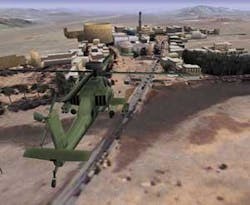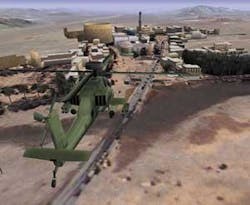By John McHale
ORLANDO, Fla. - The Boeing Co. in Mesa, Ariz., has selected the Independence IDX 2500S ER Image Generator (IG) from Quantum3D in San Jose, Calif., for the Apache Block III attack helicopter Engineering Development Simulator (EDS). Quantum3D officials made the announcement at the Interservice/Industry Training, Simulation and Education Conference (I/ITSEC) in December in Orlando.
The Apache EDS is the primary man-in-the-loop engineering simulator for the AH-64D Apache Longbow helicopter. The EDS has two full-scale cockpits mounted in stationary 20-foot domes and consists of actual Apache flight software and hardware. The EDS is used to test and validate technologies and techniques under high-fidelity simulated combat conditions.
“Independence provides key technologies that allow aircraft software to be tested in the EDS prior to actual aircraft flight testing,” says Dale Macpherson, Boeing manager of rotorcraft operations analysis.
“The Block III upgrades to the AH-64D Apache Longbow represent significant enhancements to the platform’s capabilities, which will provide the air crew with greatly improved mission effectiveness, but which also provide a unique challenge from a simulation standpoint because of the overall fidelity that’s required,” says Ross Smith, Quantum3D cofounder and president.
About AH-64D Apache Longbow
Quantum3D has delivered an initial IDX 2500S ER IG Solution to Boeing equipped with several high-resolution out-the-window visual channels and QUEST enabled sensor simulation channels. QUEST is Quantum3D’s Enhanced Sensor Simulation Technology-a combination of software and hardware technologies that provides physics-based at-aperture and post-aperture high-fidelity sensor simulation with an end-to-end pipeline that maintains 16-bits of dynamic range.
QUEST includes Quantum3D’s viXsen plug-in to Mantis, which provides radiometrically correct rendering of the material classified synthetic environment including cultural features and moving models within the appropriate waveband of the sensors being simulated.
QUEST also includes parallel rendering and low-latency pixel composition functions for enhanced performance, full-scene anti-aliasing and high availability, combined with programmable high-fidelity sensor effects and OpenGL based reticles and symbology.
With QUEST-enabled channels, Independence IDX 2500S ER IGs can support simulated sensor channels with up to 2-megapixel resolutions at 60-Hz sustained update rates while providing an industry-leading 16-bit dynamic range throughout the scene-generation and post-processing stages. QUEST also provides host-selectable hardware-accelerated sensor system effects such as blur, noise, and AC Coupling, as well as near-zero-latency reticle and symbology mixing, company officials say.
The sensors were enhanced to simulate the Apache’s advanced weapons systems, Smith says. Quantum3D engineers selected IDX 2500S sensor simulation features for Boeing to address the unique requirements of the Modernized Target Acquisition and Designation System (M-TADS) and the Modernized Pilot Night Visioning System (M-PNVS).




